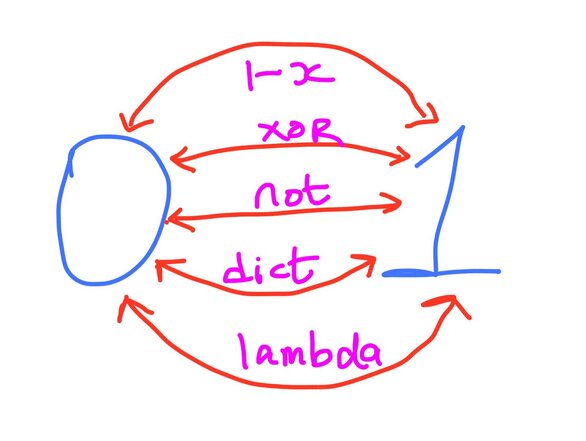Kodeclik Blog
How to flip 1 and 0 in Python
Sometimes in a Python program, you will need to swap 0 and 1 and you would like to do it in a Python-ic way. What is a Pythonic way you ask? And when would you need to so such swaps?
For instance, in low-level programming or when working with binary data, you might need to flip specific bits. Swapping 0 and 1 is essentially flipping a single bit.
In binary image processing, swapping 0 and 1 can invert black and white pixels, creating a negative of the image.
In game logic, swapping 0 and 1 can be used to toggle states, such as turning features on or off or switching between player turns.
We will see five different ways to swap 0 and 1 in Python!

Method 1: Subtraction
The simplest method to swap 0 and 1 is by subtracting the value from 1:
def swap(val):
return 1 - valThis works because 1 - 0 = 1 and 1 - 1 = 0.
Method 2: XOR operator
The XOR (exclusive or) operation can be used to flip bits:
def swap(val):
return val ^ 1This method is efficient and works by flipping the least significant bit.
Method 3: Boolean Negation
By converting the value to a boolean and negating it, we can swap 0 and 1:
def swap(val):
return int(not bool(val))This method first converts the value to a boolean (False for 0, True for 1), negates it, and then converts it back to an integer.
Method 4: Dictionary
A dictionary can be used to create a lookup table for swapping:
swap = {0: 1, 1: 0}
def swap_value(val):
return swap[val]This method is clear and easily extensible if more values need to be swapped in the future.
Method 4: Lambda Function
A concise lambda function can be used to swap the values:
swap = lambda x: 1 if x == 0 else 0This one-liner checks if the input is 0 and returns 1, otherwise it returns 0.
Understanding when and how to swap 0 and 1 is thus valuable in various programming contexts, from low-level bit manipulation to high-level application logic.
If you liked this blogpost, checkout our blogpost on how to make a number negative in Python which has similarly multiple ways to solve the same problem! Also see our blogpost on integers and their representations!
Want to learn Python with us? Sign up for 1:1 or small group classes.